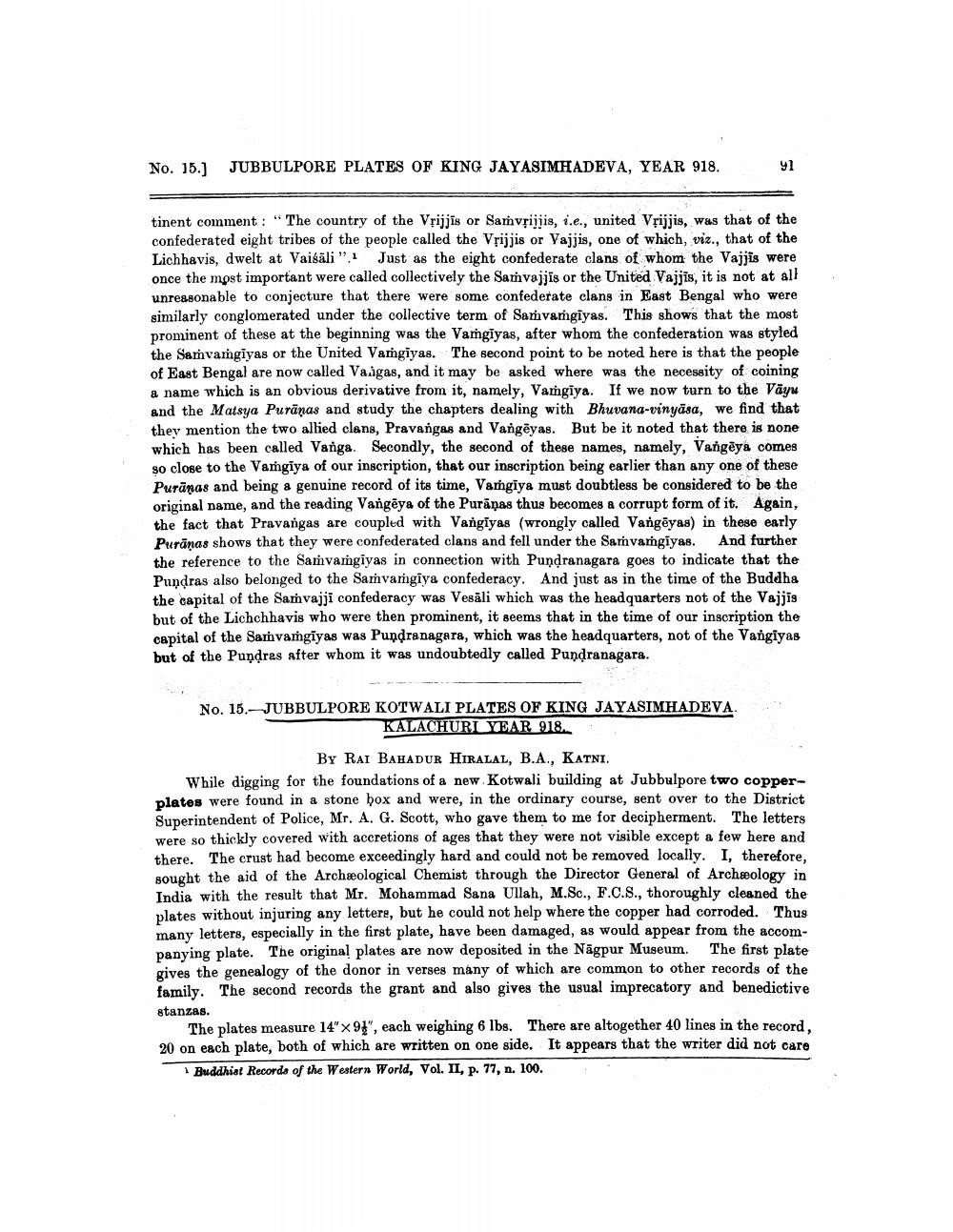________________
No. 15.)
JUBBULPORE PLATES OF KING JAYASIMHADEVA, YEAR 918.
tinent comment: "The country of the Vrijjis or Samvsijjis, i.e., united Vsijjis, was that of the confederated eight tribes of the people called the Vrijjis or Vajjis, one of which, viz., that of the Lichhavis, dwelt at Vaibali". Just as the eight confederate clans of whom the Vajjis were once the most important were called collectively the Samvajjis or the United Vajjīs, it is not at all unreasonable to conjecture that there were some confederate clans in East Bengal who were similarly conglomerated under the collective term of Samvamgiyas. This shows that the most prominent of these at the beginning was the Vamgiyas, after whom the confederation was styled the Samvamgiyas or the United Vamgiyas. The second point to be noted here is that the people of East Bengal are now called Vaigas, and it may be asked where was the necessity of coining a name which is an obvious derivative from it, namely, Vamgiya. If we now turn to the Vāyu and the Matsya Puranas and study the chapters dealing with Bhuvana-vinyāsa, we find that they mention the two allied clans, Pravangas and Vangēyas. But be it noted that there is none which has been called Vanga. Secondly, the second of these names, namely, Vangeya comes so close to the Vamgiya of our inscription, that our inscription being earlier than any one of these Purānas and being a genuine record of its time, Vargiya must doubtless be considered to be the original name, and the reading Vangēya of the Purāņas thus becomes a corrupt form of it. Again, the fact that Pravangas are coupled with Vangiyas (wrongly called VangĒyas) in these early Purānas shows that they were confederated clans and fell under the Sarvamgiyas. And further the reference to the Samvamgiyas in connection with Pundranagara goes to indicate that the Pundras also belonged to the Samvamgiya confederacy. And just as in the time of the Buddha the capital of the Samvajji confederacy was Vesāli which was the headquarters not of the Vajjis but of the Lichchhavis who were then prominent, it seems that in the time of our inscription the capital of the Samvaṁgiyas was Pundranagara, which was the headquarters, not of the Vangiyas but of the Pundras after whom it was undoubtedly called Pundranagara.
No. 15.-JUBBULPORE KOTWALI PLATES OF KING JAYASIMHADEVA.
KALACHURI YEAR 918
BY RAI BAHADUR HIRALAL, B.A., KATNI. While digging for the foundations of a new Kotwali building at Jubbulpore two copperplates were found in a stone box and were, in the ordinary course, sent over to the District Superintendent of Police, Mr. A. G. Scott, who gave them to me for decipherment. The letters were so thickly covered with accretions of ages that they were not visible except a few here and there. The crust had become exceedingly hard and could not be removed locally. I, therefore, sought the aid of the Archaeological Chemist through the Director General of Archeology in India with the result that Mr. Mohammad Sana Ullah, M.Sc., F.C.S., thoroughly cleaned the plates without injuring any lettere, but he could not help where the copper had corroded. Thus many letters, especially in the first plate, have been damaged, as would appear from the accompanying plate. The original plates are now deposited in the Nāgpur Museum. The first plate gives the genealogy of the donor in verses many of which are common to other records of the family. The second records the grant and also gives the usual imprecatory and benedictive stanzas.
The plates measure 14" x 91", each weighing 6 lbs. There are altogether 40 lines in the record, 20 on each plate, both of which are written on one side. It appears that the writer did not care
Buddhist Records of the Western World, Vol. II, p. 77, n. 100.




